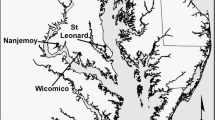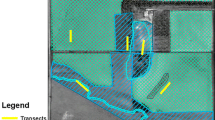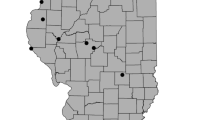Abstract
When wetlands are restored to reverse ecosystem degradation caused by anthropogenic change, the hope is that plant and animal communities will efficiently re-assemble once stressors on the ecosystem have been minimized. In many situations, however, anthropogenic change is so severe or widespread that re-assembly occurs slowly, if at all, without active seeding or planting. A common need for wetland restoration projects is to anticipate how much active intervention is needed for plants and animal communities to recover. Studies of plant reassembly in restored wetlands indicate that recolonization potential depends on three main factors: the level of site degradation, the extent of anthropogenic change to wetlands in the surrounding landscape, and the kind of wetland being restored. Which species actually become established depends on a fourth factor, the array of environmental conditions in the restored wetland. The longest lags of recolonization will likely occur in restored wetlands that lack remnant vegetation and seedbanks and that are isolated from extant wetlands. In these situations, actively seeding or planting dominant species is necessary to restore wetland vegetation.
Access provided by CONRICYT-eBooks. Download reference work entry PDF
Similar content being viewed by others
Keywords
Introduction
Wetlands are restored to reverse ecosystem degradation caused by anthropogenic change, such as land conversion, water withdrawal, or infrastructure development. A wetland ecosystem cannot recover unless the main causes for degradation are addressed. For example, if groundwater withdrawals have depleted freshwater supplies to a desert oasis, causing it to become saline, ecosystem recovery will only be possible if withdrawals are reduced. So, the primary concern of any restoration project is to identify the drivers of change and work to correct them. In some cases, once these problems have been corrected, the environmental conditions return to normal and plant and animal communities quickly rebound. In other situations, though, ecosystem stress caused by anthropogenic change is so severe or widespread that biotic recovery occurs very slowly (if at all), unless additional restoration actions are taken. A common need for wetland restoration projects is to anticipate how much active intervention is needed for plants and animal communities to recover. Doing more than is necessary, wastes limited resources and potentially can do more harm than good. However, not doing enough can result in a restoration not achieving its desired results for the foreseeable future.
In contrast to terrestrial ecosystem restoration, most restored wetlands are not planted; their plant communities are allowed to reassemble through natural processes. A key reason for this difference is that many wetland plants produce seeds that can lie dormant in the soil for many years, surviving through unfavorable periods, such as prolonged high water or drought, until conditions are suitable for germination and growth. Thus, restorationists often assume that those stores of seeds in wetland soils (seedbanks) have withstood the period of degradation and will serve as a source of colonists once abiotic problems have been corrected. Many also assume that other wetland plants will arrive on their own, either by water or transported by animals. In reality, though, the likelihood that a plant community, similar to what existed on a site prior to degradation, will efficiently recolonize is quite variable. Studies of plant reassembly in restored wetlands indicate that recolonization potential depends on three main factors: the level of site degradation, the extent of anthropogenic change to wetlands in the surrounding landscape, and the kind of wetland being restored (e.g., Matthews et al. 2009; Mulhouse and Galatowitsch 2003). Which species actually become established depends on a fourth factor, the array of environmental conditions in the restored wetland.
Seedbank Presence
If some portions of a wetland have escaped severe degradation, these areas may harbor remnant patches of the original vegetation. Vegetative spread from these remnants can be very rapid, since many wetland plants are clonal. For example, emergent aquatic plants, often found along the margins of earthen ditches and canals in drained agricultural wetlands, may vegetatively spread from these corridors if hydrology is restored (Galatowitsch and van der Valk 1995). Seeds stored in the soils of these remnants (i.e., seedbanks) may also be transported to colonize other parts of the wetland. The role of seedbanks is, however, likely to be most important for recolonization where they exist throughout a site. Seedbanks are most likely to have persisted if the duration of degradation has been relatively short and the surface of the wetland is intact (Wienhold and van der Valk 1989). If the surface is removed, for example, by excavation or sod-cutting, the seedbank is removed (Grootjans et al. 2001). Dormant seeds of a seedbank are likely to persist through unfavorable periods that are within the natural range of conditions typical of that type of wetland. For example, prairie wetlands in the mid-continental US typically experience droughts that cause drawdowns every 5–10 years that trigger emergence of emergent marsh seedlings from seedbanks. Not surprisingly, wetlands that were drained for agricultural production 70 or more years ago have diminished seedbank diversity and density. So, on-site sources of propagules will be of limited or no importance to plant community reassembly in wetlands with very long histories of degradation (especially drainage) and degradation that has affected the entire wetland.
Seed Dispersal
Plant species without on-site propagules sources can colonize newly restored wetlands, if they are dispersed there. Seeds are carried from one wetland to another by water, wind, or animals. The abundance and diversity of seeds and vegetative propagules greatly depend on the level of connectivity between restored and extant wetlands in the surrounding landscape. Restored wetlands with surface water connections have the highest connectivity and so will likely receive the greatest influx of seeds. Water is an especially important mode of transportation because the seeds of many wetland species are buoyant. Even if they lack special adaptations, many seeds can be carried in moving water. For example, of 125 plant species that dispersed into a restored tidal freshwater marsh, 89 arrived via water, whereas only 10 were carried by geese and 39 by wind (Neff and Baldwin 2005). Restored wetlands lacking surface water connections to other wetlands depend on seeds arriving by wind or animals, which is much less efficient for most species. Restored prairie potholes which depended on overland seed dispersal received seeds of very few species (i.e., 6 native perennials over two years) and few seeds overall (i.e., 20 seeds m-2 per year) (Kettenring and Galatowitsch 2011). However, restored wetlands that are near but not connected to other wetlands in the landscape can accumulate more species over time, compared to those that are more distant, even though dispersal is inefficient (Galatowitsch 2006). So, wetland loss that removes connections between wetlands or increases their isolation likely diminishes the rate of plant recolonization during restoration.
The makeup of seeds arriving via dispersal, called seed rain, reflects the species composition of wetlands serving as propagule sources. Species that are most abundant and produce the most seeds are likely to comprise a large fraction of arriving seeds. This phenomenon is called propagule pressure. Where introduced, invasive species have spread through extant wetlands, propagule pressure will favor the arrival of these species into restored wetlands. For example, 93% of the seeds dispersing into restored prairie potholes were introduced (i.e., nonnative) species (Kettenring and Galatowitsch 2011). Species assemblages in dispersal-dependent restored wetlands may have little similarity to what occurred there prior to degradation.
Disturbance Effects
The frequency and magnitude of natural disturbances varies among different types of wetlands, and so the plant communities also vary in their capacity to recolonize after disturbances. Wetland plant communities vary in seedbank development: species that form long-lived seedbanks are most likely to be found were there are multiyear phases unfavorable to plant regeneration, interrupted by natural disturbances. Natural disturbances remove adult vegetation and change environmental conditions potentially encouraging seedling emergence and growth. Species with long-lived seeds stored in the soil can capitalize on these events and so will be well-represented in the plant community. Extant emergent marshes are widely reported to have well-developed seedbanks, with densities of >10,000 m−2 not uncommon; in contrast, wet meadows seedbanks more typically have densities of <2,000 m−2 (Galatowitsch and Biederman 1998).
The extent to which alterations to wetlands, such as drainage, diminishes seedbanks could also differ among wetland types, affecting recolonization potential. For example, of three wetland types found on the Kissimmee River Floodplains in Florida that had been drained, only one type (wet prairie) contained seedbanks with many species characteristic of that habitat; broadleaf marshes and wetland shrub communities, in contrast, contained no more than one such species (Wetzel et al. 2001). In this situation, broadleaf marsh and wetland shrub communities will depend more on dispersal of propagules for plant community reestablishment after restoration, than would wet prairies. Species capable of rapid dispersal and colonization are likely to be from wetland plant communities that experience frequent disturbances, such as annual flooding and drawdowns. These species often produce abundant seed, can germinate quickly, and have relative short-times to maturity.
Within a restored wetland, plant colonization is potentially most rapid for species with on-site remnant populations that can vegetatively spread and are already producing seed. If no remnant vegetation has survived degradation, plant colonization may still be relatively efficient if many species are well-represented in the seedbank. If seedbanks are no longer present because the duration or intensity of degradation has been too great, then many colonists will need to disperse to the site. The longest lags of recolonization will likely occur in restored wetlands that are isolated from extant wetlands. In these situations, actively seeding or planting dominant species is necessary to restore wetland vegetation. Dispersal limitations have been reported from restored wetland ecosystems, including salt marsh plains (Morzaria-Luna and Zedler 2007) and prairie meadows and marshes (Galatowitsch 2006).
Seed Survival
Not all species in the seedbank or seed rain will establish populations in restored wetlands. Conditions must be suitable for germination, establishment, and growth. Ecologists use the analogy of a filter or sieve to describe how site conditions regulate which species become part of a plant community (van der Valk 1981). All of the species with seeds on a particular site are referred to as the local species pool. Key environmental factors, such as water levels, salinity, or light act as filters (or sieves), selecting subsets of species that will form the initial vegetation of restored wetlands (Keddy 1999). So, for a wetland plant community to resemble what was present prior to degradation, these environmental conditions must be similar. If some aspect of the wetland, such as the water regime, is very different than what previously existed on the site, the plant community that establishes will not be the same, even if many of the seeds (or other propagules) were present. In landscapes where many wetlands are dominated by introduced species, these species will likely arrive most rapidly. When this occurs, later arriving species may be unable to establish if the initial colonists create unsuitable conditions.
Future Challenges
For wetland restoration to be a useful conservation strategy, capable of reversing adverse impacts at the scale at which they occur, it is critical to be able to pursue projects that are much larger than are feasible today. Because wetland vegetation reassembly through natural processes is often inefficient or incomplete, especially in human-modified landscapes, active intervention (i.e., seeding or planting) is often necessary for full restoration. Project size is frequently limited in situations where humans must compensate for the lack of wetland plant colonization: commercial seed and plant supplies are often minimal or nonexistent, the logistics of acquiring and installing seeds and plants is often very expensive, and seed technology information is lacking for wetland species. Thus, in most parts of the world, research on the seed technology and horticulture of wetland plants is needed to improve the efficiency of producing wetland plants and seeds in large quantities. This kind of research has been essential for expanding agricultural opportunities worldwide and, more recently, for facilitating terrestrial ecosystem restoration (especially grasslands). In some cases, methods from terrestrial species for production, handling, storage, and installation can be adapted for wetland species; however, new approaches will frequently be needed since these species are adapted to life in wet environments.
References
Galatowitsch SM, Biederman LA. Vegetation and seedbank composition of temporarily flooded Carex meadows and implications for restoration. Int J Ecol Environ Sci. 1998;24:253–70.
Galatowitsch SM, van der Valk AG. Natural revegetation during restoration of wetlands in the southern prairie pothole region of North America. In: Wheeler BD, Shaw SC, Fojt WJ, Robertson RA, editors. Restoration of temperate wetlands. Wiley: Chichester; 1995. p. 129–41.
Galatowitsch SM. Restoring prairie pothole wetlands: does the species pool concept offer decision-making guidance for revegetation. Appl Veg Sci. 2006;9:261–70.
Grootjans AP, Everts H, Bruin K, Fresco L. Restoration of wet dune slacks on the Dutch Wadden Sea islands: recolonization after large-scale sod cutting. Restor Ecol. 2001;9:137–46.
Keddy P. Wetland restoration: the potential for assembly rules in the service of conservation. Wetlands. 1999;19:716–32.
Kettenring K, Galatowitsch S. Seed rain of restored and natural prairie wetlands. Wetlands. 2011;31:283–94.
Matthews JW, Peralta AL, Flanagan DN, Baldwin PM, Soni A, Kent AD, Endress AG. Relative influence of landscape vs. local factors on plant community assembly in restored wetlands. Ecol Appl. 2009;19:2108–23.
Morzaria-Luna HN, Zedler JB. Does seed availability limit plant establishment during salt marsh restoration? Estuar Coasts. 2007;30:12–25.
Mulhouse JM, Galatowitsch SM. Revegetation of prairie pothole wetlands in the mid-continental US: twelve years post-reflooding. Plant Ecology. 2003;169:143–59.
Neff KP, Baldwin AH. Seed dispersal into wetlands: techniques and results for a restored tidal freshwater marsh. Wetlands. 2005;25:392–404.
Van der Valk AG. Succession in wetlands: a Gleasonian approach. Ecology. 1981;62:688–96.
Wetzel PR, van der Valk AG, Toth LA. Restoration of wetland vegetation on the Kissimmee River floodplain: potential role of seed banks. Wetlands. 2001;21:189–98.
Wienhold CE, van der Valk AG. The impact of duration of drainage on the seed banks of northern prairie wetlands. Can J Bot. 1989;67:1878–84.
Author information
Authors and Affiliations
Corresponding author
Editor information
Editors and Affiliations
Rights and permissions
Copyright information
© 2018 Springer Science+Business Media B.V., part of Springer Nature
About this entry
Cite this entry
Galatowitsch, S. (2018). Plant Community Reassembly in Restored Wetlands. In: Finlayson, C.M., et al. The Wetland Book. Springer, Dordrecht. https://doi.org/10.1007/978-90-481-9659-3_327
Download citation
DOI: https://doi.org/10.1007/978-90-481-9659-3_327
Published:
Publisher Name: Springer, Dordrecht
Print ISBN: 978-90-481-3493-9
Online ISBN: 978-90-481-9659-3
eBook Packages: Biomedical and Life SciencesReference Module Biomedical and Life Sciences




